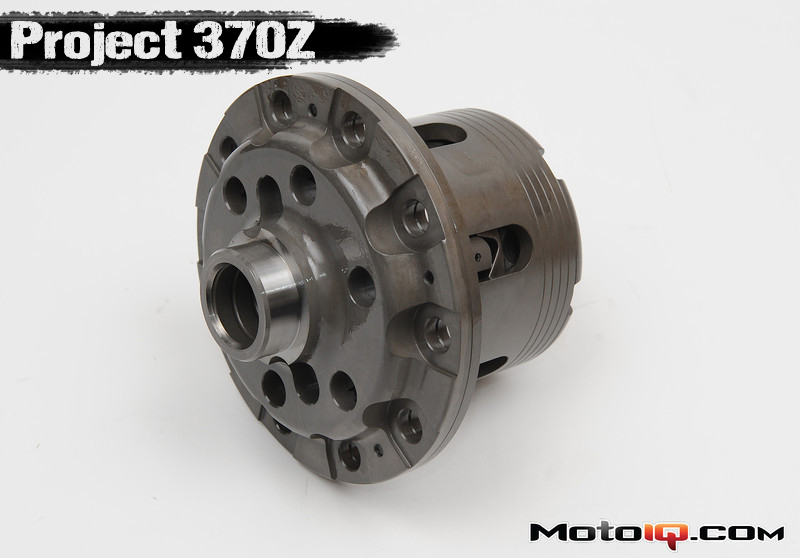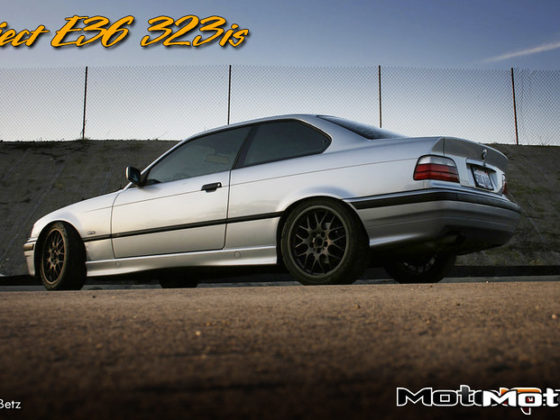,
 |
| The end caps are unbolted and the stock diff is lifted out of the case. Then the ring gear bolts are removed. |
 |
| We selected the Cusco RS diff because of its great amount of adjustability. However the diff is set up relatively tight from Cusco which makes it work better in a drift car rather than a street class time attack car like our 370Z. We have to take some steps to make our diff better suited for grip driving. To adjust the diff you first disassemble it by removing the screws that hold the end cover of the diff and dumping out the stuff inside. |
 |
| Here are the major components that affect adjustability, the pressure rings and the pinion gears on the cross shaft assembly. In a diff the pinion gear is driven by the engine which in turn drives the ring gear which is solidly bolted to the differential case. The pressure rings are driven by the case through lugs on the rings and grooves on the diff case itself. The pressure rings transfer torque to the pinion gears through the cross shafts that sit in windows on the pressure rings. The pinion gears drive side gears that are attached to the axles. The pinion gears allow the side gears to move independently from each other. In a Salisbury limited slip differential, two multi disc clutch packs (one on each side of the differential case) have drive discs attached to the diff case and driven discs attached to the side gear. If the wheels try to move against each other with a load, the twisting of the side gears causes the cross shaft to twist against the pressure rings. The ends of the cross shafts are shaped like cams that apply a wedging force to the specially shaped windows in the pressure rings causing them to wedge outward and apply the clutches. The greater the torque load and differential of speed between the two wheels the greater the wedging force. |
 |
| In a limited slip diff, the amount of resistance for the wheels to spin independently of each other with no load is called the initial breakaway torque. For a drift car, you want the torque to be really high so it will be easy to get the car sliding sideways when the throttle is applied. For a grip car, you want less initial breakaway torque so both wheel can find maximum traction as the gas is squeezed down from mid turn outward. Another thing initial torque affects a lot is turn in. A lot of initial torque might make the car want to understeer on turn in and suddenly transition to oversteer when trail braking. On a typical diff the breakaway torque is controlled by cone springs, typically a springy conical giant washer that applies preload to the clutches. The only way to adjust the breakaway torque in this case is if your diff manufactures make cone springs of different weights or if you make some shims about 0.010 to 0.015″ out of shim stock to increase the preload. Not the easiest or most flexible thing to do. In the case of the Cusco RS, it is much easier to adjust the initial breakaway. The RS uses coil springs to apply outward force to the pressure rings. The RS can use up to 12 springs for maximum clamping force. We elected to use half of that, six springs. You can adjust the pressure by adding or subtracting springs. |
 |
| We placed the six springs evenly around the pressure ring. A big advantage that coil springs have over cone springs is that they have a lot more travel in them which means that the preload stays pretty consistent as the clutch packs wear. With cone springs the spring rate declines a lot with small distances and the clamp force drops fast as the clutches wear. In case you are wondering, cone springs are capable of crating more initial break away clamp load so for certain applications like hard core drifting where you want very aggressive differential action they work better. In this case Cusco makes a cone spring diff called an RZ. A neat thing is that you can convert an RS to an RZ easily! More on that later. |




6 comments
Thank you for your really excellent explanation of how these components work.
One question: Gear type differentials (Torsen), appear to me to offer perfect distribution of power at all time. They are strong and require essentially no maintenance or replacement of parts.
What is the advantage of the Salisbury clutch type that you chose?
If the car was to be used exclusively on the street, would you have made the same choice?
They work better, torsens are really not that great.
Great write up, what lock rate was selected 60%, 80% or 100% for your build?
A youtube channel mentioned cusco recommended to leave it at 100% and only mess with the spring preload because with lower lock up rates the disc tend to run hotter. is this true?
Hey Mike – would you be able to do a detailed article on LSD tuning in all aspects?
1) Initial Breakaway torque
2) Ramp angles
3) Belleville thicknesses and spring rates
4) Different clutch plate treatments and surfaces
5) Different clutch plate materials (steel/carbon)
6) Tuning with different oils and additives
From the rabbit hole that i’ve gone down, it seems that most people only focus on the initial breakaway torque and that’s it. But having different spring rate bellevilles (cone washers) or stacking these washers also effect the LSD and how it behaves and reacts.
For example, the ATS carbon LSD needs ~250ftlb breakaway torque, but yet it doesn’t cause the wheels to skip/chatter in the parking lot. But a metal LSD with 80ftlb breakaway torque can skip/chatter with small steering input.
Something as simple as removing one of the belleville/cone washers and replacing it with a spacer and setting the same breakaway torque. How will that effect the LSD and driving?
Cheers, Mike
We did a few already, a couple of youtube video too. search is your friend.
We have several, use the search function. Videos too on youtube. We have never tuned an ATS diff before except for drifting and we didn’t like it and ended up going back to a spool.